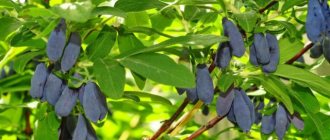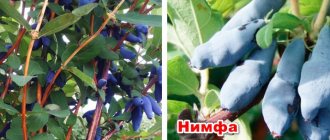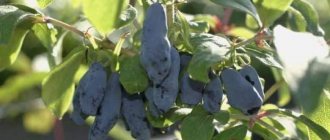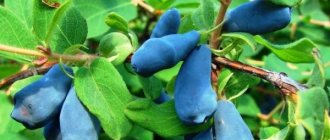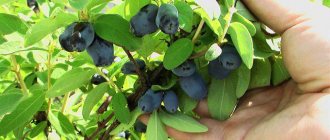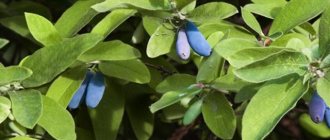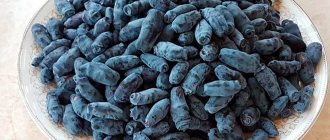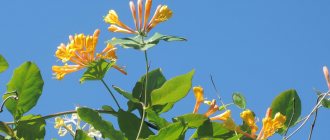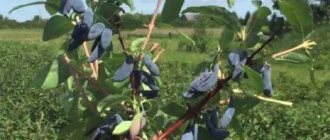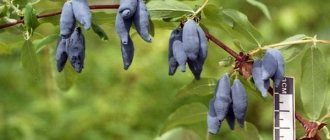Benefits of honeysuckle
The fruits are endowed with a pleasant, sweet taste; many varieties have a slight bitterness. Honeysuckle contains a lot of substances that are beneficial for the body. Not only are jams made from the berries, they are added to compotes, medicinal infusions and decoctions are made, and fresh ones are often added to tea for flavor. Honeysuckle is useful for diseases of the heart, blood vessels, and gastrointestinal tract. Fruits cleanse the body of toxins, “bad” cholesterol, toxins, and help improve immunity.
The fruits are not contraindicated for consumption by people with diabetes; they are recommended for hypertension. Honeysuckle is a real natural first aid kit. Scientists have proven that its constant consumption significantly rejuvenates the body and slows down the aging process. We invite you to get acquainted with Silginka honeysuckle. A description of the variety will be given below.
What varieties of honeysuckle should be planted together?
All varieties of blue honeysuckle are self-sterile. For pollination of flowers and the appearance of berries, representatives of another variety must be present within reach. The more there are, the richer the harvest. When selecting varieties for the garden, it is necessary to take into account the flowering time of plants. If they do not match, pollination will be impossible and fruits will not set.
According to most breeders, the taste of the berries and the size of the harvest depend on the choice of pollinator.
Table: the best pollinators for popular varieties
| Main variety | The best pollinating varieties |
| Siberian |
|
| Nymph |
|
| Silginka | Bakchar giant |
| Cinderella |
|
| Bakchar giant |
|
| Leningrad giant |
|
| Blue spindle |
|
| Swan |
|
| Blue bird |
|
| Amphora |
|
| Moraine |
|
| Malvina |
|
| The Giant's Daughter |
|
| Sweet tooth | Violet |
An important condition for obtaining a good harvest of honeysuckle is the correct choice of variety. In this case, it is necessary to take into account not only your own preferences, but also the climatic conditions of the region in which cultivation is planned. If this rule is followed, honeysuckle will delight the gardener for a long time with tasty and healthy berries.
- Author: Galina Panova
Since childhood, I have been interested in growing various plants and have achieved considerable success in this matter. I will be very happy to share my experience. Rate this article:
- 5
- 4
- 3
- 2
- 1
(58 votes, average: 3.5 out of 5)
Share with your friends!
Honeysuckle Silginka: description of the berry
A distinctive feature of the variety is that the berries do not have the bitterness characteristic of many varieties of honeysuckle. The taste is very pleasant, sweet, refreshing. The berries are all the same size, their average weight is 1.4 grams. These large fruits are dark blue with a slight purple tint. The surface of the skin is covered with a white waxy coating. It is thin, but dense enough to protect the pulp from damage. The skin is tender, almost imperceptible when eaten. The pulp is juicy, refreshing, aromatic. The honeysuckle variety Silginka received a high tasting score, scoring 4.9 points out of five possible.
Photo of bush and berries
The photo of the variety shows a shrub with a rounded crown. Honeysuckle is characterized by medium density. The plant has many erect shoots.
We recommend that you read: Pruning raspberries for the winter
Dark green leaves of oval-elongated shape. Buds appear in their sinuses. The tubular flowers are large, and their arrangement in inflorescences is in pairs. The fruits are large with smooth skin. It has a shiny surface. The berries hang in clusters or may grow together into one fruit.
Characteristics of the variety
Gardeners love this honeysuckle because it is suitable for absolutely all regions. It tolerates heat and drought well and is not at all afraid of frost. The yield of the variety is high; according to statistics, from one bush you can collect from two and a half to three kilograms of fruit. Ripe berries can be stored for up to a month in a cool, dark place. Transportability is average, can be transported over short distances.
The peculiarity of Silginka honeysuckle is that fully ripened berries do not fall off the branches, they continue to wait until they are picked by the caring hand of the owner. Ripening occurs simultaneously, this is a huge advantage. It will appeal to gardeners whose plots are located far from their permanent place of residence. Silginka honeysuckle needs pollinators for good productivity. The best variety for her will be the Bachkarsky Giant variety. Planting shrubs together will allow you to obtain high and stable yields from both species, bearing fruit simultaneously.
No shortcomings have been identified in the variety; absolutely everyone who decides to plant it on their plot likes it. A photo of Silginka honeysuckle is presented in this publication.
How was the variety created?
Its history is simple and sparse. Created in Siberia, through the works of breeders of the Bakcharsky research nursery, famous in the Tomsk region. Year of birth: 1978, this is one of the first “cultivated” varieties of honeysuckle. It was obtained by crossing two varieties: Roxana and Turchaninova. When creating Silginka, the authors sought to obtain a plant that can withstand severe frosts and spring frosts well, and also produces tasty fruits of commercial quality. And the breeders succeeded in this!
Preparing the landing site
This variety, however, like all others, is undemanding to the condition of the soil; it can be loam or sandy soil. The main criterion is the presence of good lighting and protection from winds. The more sun the bush gets, the better the taste of the berries and the higher the yield.
When preparing holes for planting, consider the distance between them. The bushes should be located at a distance of one and a half meters from each other. The depth of each hole should be from fifty to sixty centimeters.
Agricultural technology
The main requirement for growing honeysuckle is the availability of free space. The bush can live up to 100 years and its diameter is at least 1.5 m. In addition, to get a harvest you need to plant at least 2 different varieties of bushes.
Did you know? If the shrub is older than 4 years, you may notice the bark peeling off, revealing wood underneath. This condition is not a disease, but a feature of the bush that does not require any action from the gardener.
There are also a few other points to consider:
- A seedling with a pair of strong stems and no external damage is suitable for planting.
- Despite the fact that the variety tolerates any lighting well, the more sunlight “hits” the bush, the more fruits you will get.
- Plants are planted in well-drained soil at a distance of 1 meter from each other.
- Honeysuckle will need high-quality watering.
- Be sure to spray against pests. Aphids and bugs “adore” this shrub.
Remember that semi-evergreens shed most of their leaves in late winter, just before new ones begin to grow in the spring, and so the bushes remain leafless for a short time
Selecting a location
Honeysuckle is undemanding to growing conditions, as it grows everywhere in the wild, including on rocks. But it is preferable to choose an area for planting with drained soil and good lighting . Avoid planting in wetlands and low-lying areas where damp air accumulates.
Important! During the first 2
—
3 years after planting honeysuckle, only watering and weed removal are required.
Regardless of which site is chosen, the plant will definitely need support for the stems . This could be a wire lattice, a fence, the wall of a building, or a trellis. Walls facing south are excellent for bushes to produce the maximum amount of fruit. The absence of sun will result in a lack of flowering. And soil that is too clayey and poorly permeable to moisture can cause disease.
Planting and care
You can buy and plant plants in both spring and autumn. It is important to do this when there is no threat of frost. According to gardeners, it is more correct to plant deciduous varieties in the fall, and evergreens in the spring or autumn.
Prepare a supporting structure: trellis or lattice. Place the wires about 45cm apart. There should be at least 10 cm of space between the supporting structure and the bush. This will create conditions for air flow around the plant, and will also allow the gardener to care for the bush - pruning and harvesting.
Video: Planting a honeysuckle seedling
Planting technology:
- The distance between plants is about 1-1.5 m, depending on the “adult” size of both bushes. When planting in rows, a minimum width of 2 m will be required between them.
- A hole about 50 cm deep and the same width is dug in the area. You need to focus on the size of the root ball, to which 20 cm is added in order to relieve soil pressure and improve conditions for root growth.
- If the soil is clayey, then the excavated soil is mixed with compost (1 bucket) or other organic fertilizer.
- Pour some of the soil mixture into the hole.
- Carefully remove the seedling from the container in which it arrived from the nursery. And without removing the soil from the roots, lower it into the recess.
- Add soil to half the volume of the planting hole.
- Water thoroughly.
- Add the remaining soil. Compact to remove air pockets.
- Now prune the existing shoots back by two-thirds to encourage new shoots to grow at the base. This will also promote the growth of the root system.
Check the soil moisture regularly, and water the plant at least once a week during the first growing season . Dry areas may require more frequent watering.
Feed honeysuckle once a year (in spring). On a clay plot you will need 2 buckets of compost, 50 g of superphosphate and 50 g of potassium salt. To apply them, create a small furrow around the perimeter of the bush, pour fertilizer into it and fill it with water - this way they will be better absorbed. Then the furrow is filled in.
If the root zone is covered with mulch, this will keep moisture from evaporating, the soil from compacting and will prevent the growth of weeds. During watering, the mulch partially decomposes and nourishes the soil with useful substances. But this only applies to organic types of mulch: wood chips, pine needles, straw or sawdust.
Features of pollination
In spring, honeysuckle blooms profusely. Its flowers are bisexual. But they are self-sterile and to obtain a harvest, it is necessary to have another variety nearby with which it will be pollinated.
The originator of Silginka indicates that the following varieties are suitable for pollination: Vostorg, Yugan, Bakcharsky giant, Sinilga, Daughter of the giant. Pollen is carried by bees and other insects. Gardeners note that the more different varieties grow in the garden, the greater the yield will be obtained from the plants.
Important! Be sure to take into account that each flower will bloom only for 1 day. If there are few bees in the garden, spray the bush with sweet water. Its aroma will attract pollinating insects.
Disease and pest control
Honeysuckle is a “reliable” plant that rarely gets sick. For Silginka, it is indicated that its resistance to disease is at the standard level.
However, in hot weather it is prone to contracting powdery mildew . The disease most severely affects honeysuckle growing in a shady place. The fungus appears as a white powdery coating on the leaves. They subsequently darken, dry out and crumble. To combat the fungus in the fall, they destroy fallen leaves, weeds and other organic remains on which spores can overwinter. If a disease is detected, the bushes are sprayed with a sulfur solution.
If you notice spots on the leaves, then this is the result of the activity of various fungi. To combat them, spray with 1% Bordeaux mixture before flowering, after flowering and in the fall.
In the spring, check young shoots, as they may be susceptible to aphid attack . Insects settle in colonies on leaves and cuttings. They are removed by spraying with soapy water at intervals of 7 days.
Scale insects can also attack young shoots . As a result, the shoot slows down in growth and dies. The insect is covered with a chitinous shell, under which chemicals do not penetrate. Therefore, scale insects are removed manually by cleaning them from the shoots.
Pruning and crown formation, preparation for wintering
It is necessary to prune the bush so that the honeysuckle bears fruit abundantly. The plant “gives” up to 12 new shoots in one year. Therefore, it must be thinned out.
Did you know? Honeysuckle is often used in making toys for cats. Animals are attracted to its scent. The plant is also used in making aromatic pillows for people.
Trimming algorithm:
- In the spring, before the buds open, remove those shoots that were broken in winter by the wind or animals. Next, cut all stems to a height of 60 cm to stimulate the development of new ones. To stimulate flowering, the lateral branches are shortened, leaving short shoots of 2–3 buds.
- In autumn the bush is rejuvenated. This is done once every 4-5 years. Remove all old shoots older than 4 years, then those that creep along the ground and weak ones. Branches with small growth are shortened.
Honeysuckle is frost-resistant. Therefore, the bush does not need winter protection
Landing
Before planting, it is necessary to prepare the holes. Each needs to be filled one-third with good rotted humus, two hundred grams of complex fertilizer added, and if the soil is acidified, then it needs to be neutralized by adding a glass of dolomite flour or wood ash. After this, fertile soil is added. If all these recommendations are followed, then for the next three years there will be no need to feed the plant; such pre-planting refueling will be sufficient for this time.
The Silginka honeysuckle seedling must be prepared for planting. It is necessary to place the roots in water for several hours so that they are sufficiently saturated. After this, it is recommended to treat them with a root former, this will allow the seedling to take root faster and grow.
Place the seedling in the hole so that the root neck remains on the surface. Spread the roots evenly and sprinkle with soil. After this, you need to press the soil around the trunk and compact it a little. Water thoroughly, adding ten liters of water under each bush.
Further care
Silginka honeysuckle will grow well in moist soil; it also likes humidified air. Water abundantly, and in the evening she will not refuse to “take a shower.” The foliage will straighten out, become moisturized, and the plant will thank you in return, bearing good fruit.
There should be no weeds near the bushes; weed so that the grass does not take nutrients and moisture from the cultivated plant. It is necessary that air penetrates well into the soil, so loosening is required. Carry out the procedure very carefully so as not to accidentally damage the root system with the tool.
To save yourself the hassle, mulch the soil around the bushes. Sawdust or peat laid in a two-centimeter layer is suitable. This will prevent the development of weeds and retain moisture in the ground.
Three years after planting the plant, provided that it was planted according to all recommendations, it will be necessary to fertilize annually. In the spring, when the buds swell, nitrogen fertilizers will be needed. In summer and autumn, potassium and phosphorus preparations are needed, and the addition of other microelements is also necessary.
Features of cultivation
Silginka can be grown in private farms, or can be used for industrial breeding. In addition to high resistance to low temperatures, the plant tolerates heat well, but at such times it is important to ensure sufficient moisture supply.
The process of growing honeysuckle
Honeysuckle Pride of Bakchar
It is characterized by rapid, energetic growth. Three or four years after planting, you can get a well-fruiting adult plant. An important condition for successful growth of the bush is good lighting. Lack of sufficient light can affect the taste and volume of the harvest.
Soil preparation
Kamchatka honeysuckle Silginka is not picky about soil. Bushes can germinate with equal success on sandy soils or loam. It is important that the chosen location is well lit and protected from drafts and wind.
Note! When grown in the shade, thin, elongated shoots will be observed, as well as a not too abundant harvest.
The hole for planting is dug to a depth of at least 40 cm and a width of 60 cm. There, for each new bush, you should first add a glass of wood ash and a bucket of humus or compost. After planting, the area around the trunk is mulched with peat.
Landing
The most important step in growing this plant is planting itself. You can grow a representative of the Silginka honeysuckle variety by sowing seeds or planting ready-made seedlings. Naturally, purchasing ready-made seedlings in a specialized store is the most proven option. Seeds can be taken from any ripe berry, but you should be prepared that this method is very labor-intensive and time-consuming. It will take years to wait for the first harvest.
The most reliable way of propagation is to purchase seedlings
Good to know. In spring, honeysuckle roots young shoots well. If you sprinkle them with soil and water them regularly, roots will quickly appear.
So, you can propagate the plant in several ways:
- By cuttings . Annual shoots that have retained their green color are suitable for such purposes. The branch is not cut, but broken off right at the heel. Then placed in a greenhouse (you can use a plastic bottle);
- By layering . A branch of an adult plant is buried near the bush without pruning. Rooting occurs, and the bush can be moved to a new location the following year;
- Seeds . As noted, this is a labor-intensive and time-consuming option. After separation, the seeds are put in the refrigerator for a month, then sown in plastic containers and buried under the snow. After germination in the spring, care is carried out as for ordinary seedlings;
- Bush division . The honeysuckle bush is dug out completely, after which it is carefully divided into the required number of parts.
Watering and weeding
The Silginka Honeysuckle variety is distinguished by its love of moisture, so regular watering is required. But at the same time, it is not permissible to allow water to stagnate - the root system may begin to rot. Watering is best done after sunset to prevent the formation of an airtight crust on the surface.
The plant is not averse to spraying procedures. The leaves straighten and more buds form on the shoots.
An important feature of honeysuckle bushes is the close location of the roots to the surface. Weeding and loosening are carried out very carefully, without driving garden tools deep. It is important to promptly remove weeds that can take nutrients from the bush, affecting growth and yield.
The roots are located near the surface, so loosening and weeding should be done very carefully
The plant itself forms a crown of the correct shape, so it is not worth cutting often. Regularly, you should simply remove old dry branches that interfere with the formation of new shoots.
Top dressing
Fertilizers are applied annually. Moreover, at different periods of plant growth, different options for nutritional compositions are required:
- During the period of bud swelling, it is recommended to add nitrogen compounds, which promotes abundant and proper formation of buds;
- During the period of active growth and flowering, it is necessary to fertilize with organic compounds, which must necessarily contain phosphorus and potassium;
- Final fertilizing is carried out after harvesting with organic fertilizers to prepare the bush for winter.
Interesting. If you mulch with peat, rotted leaves and sawdust, the plant is provided with additional nutrition.
Diseases and pests
A feature of Silginka honeysuckle is its increased resistance to various bacterial and fungal infections. Such diseases are extremely rare, which cannot be said about insect damage.
Among the most common pests are:
- The honeysuckle pollenfly, which drinks sap from the leaves and also feeds on the fruits;
- Aphid;
- Weevil.
Pollenfly is the most dangerous enemy of honeysuckle
If representatives of these insects are noticed on the site, then you should definitely start eliminating them. The drug “Decis” has proven itself to be an excellent means of controlling insects. Two milliliters of the product are added to 10 liters of water and the treatment is carried out.
Reproduction
There are several ways to propagate honeysuckle in your area. We invite you to familiarize yourself with each one.
- By cuttings. For this method, you need to select annual green shoots at the end of May. In order for the new plant to take root better, do not cut the branch, but break it off right at the heel. After this, plant the cuttings in moist, loose soil and create greenhouse conditions. To do this, you will need to place a cut plastic bottle on top of it.
- By layering. Propagation is carried out as follows: bend the lower annual branch in the ground, secure it with a bracket and sprinkle the contact area with earth. After a year, the shoot will take root, and you can separate it and plant it in another place.
- Seeds. The process is complex and long, but we will still describe it. Select ripe berries from the bush, crush and separate the seeds, rinse. Put it in the refrigerator for a month, then sow it in a plastic container and bury it under the snow. In spring, cover the box with film and care for the seedlings as if they were seedlings.
- The last method is to divide the bush. To do this, dig up a bush with its roots, carefully divide it into the required number of parts, and plant it.
Reproduction methods
Honeysuckle propagates easily. This is one of its advantages - planting material is not cheap. Amateur gardeners can divide a young, overgrown bush or dig in cuttings. This method of propagation, like seed, is of interest exclusively to breeders - cross-pollination does not allow young plants to inherit varietal characteristics. Of the green and lignified cuttings, at best 20-30% survive among amateurs, and then only with proper care.
Honeysuckle Silginka: reviews
As we have already written, there are no shortcomings in the variety, and this is confirmed by the comments of gardeners. They write that the yield is excellent, the fruits are large, their taste is excellent, and the pulp is juicy. They praise the aroma of the berries and their versatility.
Reviews about the plant in general are also good. They write that the bushes are unpretentious, it does not require much time and effort to care for the plant, it does not thicken, so there are no problems with frequent haircuts. It looks good on the site, the bushes are neat, beautiful, and look great along paths and near fences.
We hope our recommendations will help you grow a healthy bush that will produce a bountiful harvest!
